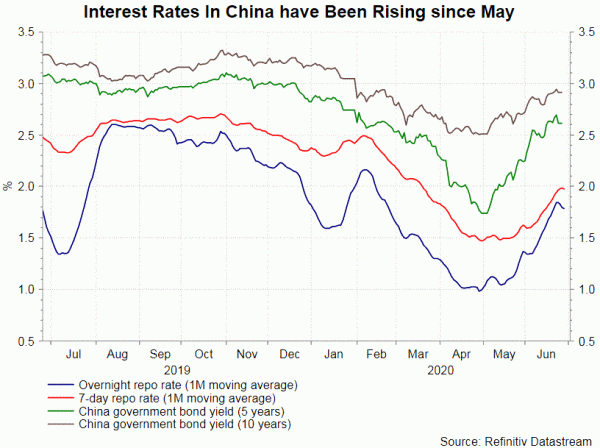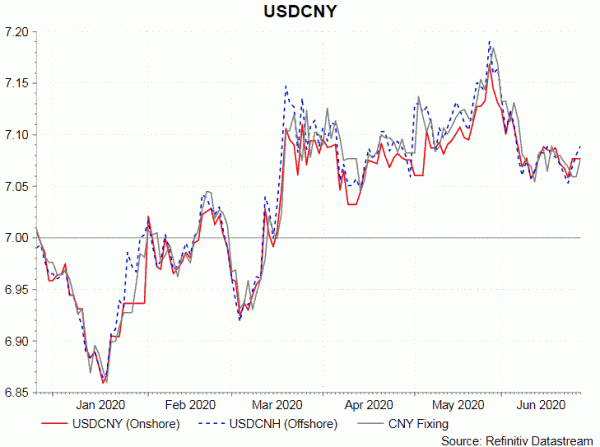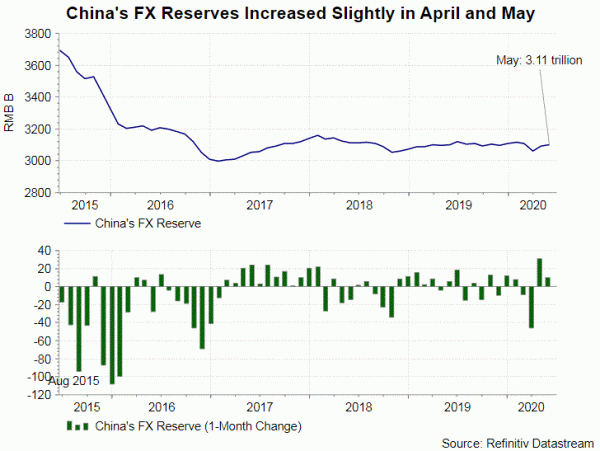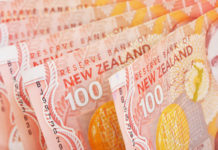The phenomenon of rising interest rates since early May appears contradictory to Chinese government’s commitment to maintain “liquidity at a reasonably ample level”. PBOC’s leaving of the loan prime rate (LPR), China’s policy rate, unchanged in May and June has fueled speculation about a shift in monetary policy stance. While we believe the bias remains skewed towards monetary expansion, inaction of the government has again revealed the government’s conflicting goals of boosting growth and controlling debt rise. As the worst point of the coronavirus pandemic has probably passed, China might now put more focus on managing financial risks. We expect the pace of cutting interest rates and RRR would likely be slower.
 Financial conditions in China have tightened over the past 2 months. The one-month rolling average for the overnight repo rate has jumped from 0.98% in end-April to 1.82% as of June 25, up +83 bps. The one-month rolling average for the 7-day repo rate has increased +48 bps to 1.98% during the period. Meanwhile, government bond yield have also soared remarkably. The magnitudes of increase are similar to rate hikes. Some suggested that the government has turned less aggressive in add stimulus to market, as the economy recovers. Others believed that the government attempted to support the renminbi by allowing interest rates to rise. Some also noted PBOC is concerned about the arbitrage opportunities provided by the recent yield structure.
Financial conditions in China have tightened over the past 2 months. The one-month rolling average for the overnight repo rate has jumped from 0.98% in end-April to 1.82% as of June 25, up +83 bps. The one-month rolling average for the 7-day repo rate has increased +48 bps to 1.98% during the period. Meanwhile, government bond yield have also soared remarkably. The magnitudes of increase are similar to rate hikes. Some suggested that the government has turned less aggressive in add stimulus to market, as the economy recovers. Others believed that the government attempted to support the renminbi by allowing interest rates to rise. Some also noted PBOC is concerned about the arbitrage opportunities provided by the recent yield structure.
Shift to Tightening Unlikely as Economy Struggling to Recover
While it is true that the worst point of China’s economic contraction has been passed, the pace of recovery is very gradual. Major economic indicators in May missed expectations despite improvement from April. Against this backdrop, it is premature for policymakers to call an end to the easing cycle. Slowing inflation has indeed increased the flexibility of easing measures. USDCNY soared to 8-month high of 7.168 on May 27 before correction. Weakness in renminbi was due to concerns about economic recovery in China, the country of origin for coronavirus outbreak and the world’s factory. The depreciation was not excessive and should not trigger government’s intervention. Indeed, foreign reserve in China, increasing slightly in April and May, also showed no signs of intervention in support of the exchange rate.
Arbitrage Opportunities Intensify Debt Problem
The recent yield structure has presented arbitrage opportunities. Investors can borrow borrow at the short-term rate and invest in the front end and belly of the bond curve, exploiting the lower overnight and 7-day repo rates and higher open market operations (OMO) rate. They can also borrow cheap money and invest in higher-yield investments. These have encouraged leverage, thus raising financial risks. Indeed, the surge of debts has been a headache since the government’s liquidity injection measures in the aftermath of the 2007/08 global financial crisis. The chart below shows that total debt in China soared to 250% of GDP as of 2016. While the ratio was similar to the US and Eurozone, and lower than Japan, the steep rise since 2008 was worrisome. Non-government debt rose to over 200% of GDP as of 2016, higher than other major economies. In his first address at the national financial work conference, Xi Jinping in July 2017 stressed the need to strengthen regulation and to reduce systemic risk in the financial system. He named deleveraging as the first priority.
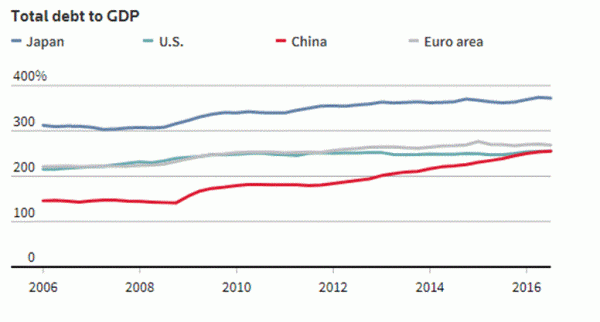
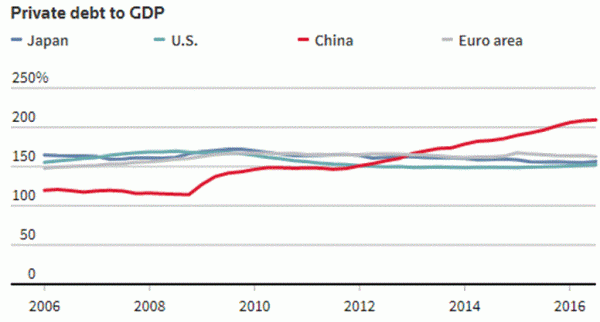
PBOC’s efforts to control financial risks through tighter monetary measures have been suspended since the start of the US-China trade war. The severe impact of trade frictions on the economy has forced the central bank to shift the focus to “stimulating growth” from “reducing debts”. The central bank has intensified its efforts to boost the economy through cutting RRR and interest rates in first quarter of this year due to the coronavirus outbreak.
Liquidity injection has just intensified the debt problem. China’s total debt hit 317% of GDP in 1Q20, up from 300% in 4Q19, the largest quarterly increase on record. Moreover, Moody’s latest report suggested that broad shadow banking assets increased for the first time in 2.5 years, rising RMB100B to RMB 59.1 trillion, in 1Q20. The ratio of shadow banking assets as a share of nominal GDP climbed higher to to 60.3% during the period from 59.5% at the end of 2019. Moody’s warned in the report that “increased policy focus to support economic recovery will fuel further expansion of shadow credit”.
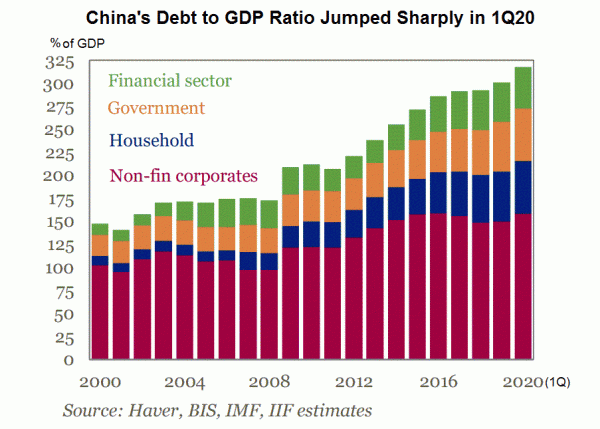 PBOC’s inaction over the past 2 months has led to increase in bond yields. We, however, do not believe the central bank has finished with monetary easing, as economic activities have remained quite weak. We expect the next move will still be a cut (on RRR or interest rate). We expect the pace of monetary easing will slow as the government struggles to strive a balance between stimulating growth and reducing debts.
PBOC’s inaction over the past 2 months has led to increase in bond yields. We, however, do not believe the central bank has finished with monetary easing, as economic activities have remained quite weak. We expect the next move will still be a cut (on RRR or interest rate). We expect the pace of monetary easing will slow as the government struggles to strive a balance between stimulating growth and reducing debts.




